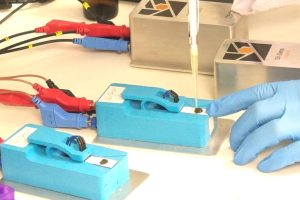A new type of light sensor could support medical and security imaging, and also work with low cost cameras. This is the promise of new research at Surrey University.
The new ‘multispectral’ light sensor detects the full spectrum of light, says the university, from ultra-violet (UV) to visible and near infrared light.
One application could be non-invasive medical procedures, such as measuring the oxygen level in tissue and detecting tumours.
“Until now specialist light sensors have been limited in the kinds of light they can detect, with multiple sensors required to measure different ranges of the light spectrum, significantly increasing cost,” said lead researcher Dr Richard Curry from the University of Surrey’s Advanced Technology Institute.
“The new technology could allow surgeons to ‘see’ inside tissue to find tumours prior to surgery as well as equip consumer products, such as cameras and mobile phones, with night imaging options. This is useful for capturing quality pictures in the dark, and may eventually enable parents to simply monitor a child’s blood or tissue oxygenation level via a smartphone camera which could be linked to healthcare professionals.”
Other possible uses include security camera systems and quality control in the agriculture and food industry.
According to the university, the sensors can be produced cheaply, using the same laser-printers found in homes and offices, and do not require specialised manufacturing conditions.
The research has been published in Nature‘s Scientific Reports.
Image: Surrey University – Photograph of two typical C60 nanorod photoconductor devices fabricated on a flexible PEN substrate. The active area covers the region of interdigitated electrodes which measures 5 x 5 mm.
 Electronics Weekly Electronics Design & Components Tech News
Electronics Weekly Electronics Design & Components Tech News




